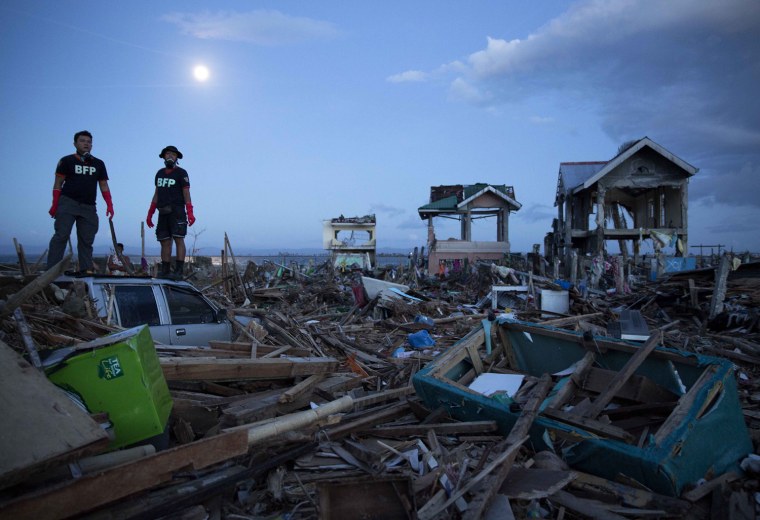More than a week after one of the most powerful typhoons ever recorded tore through the Philippines, the government and international and national humanitarian agencies face an enormous and difficult task getting aid to those who need it most, leaving little time to begin assessing the damage.
Most of what is known about the disaster so far has come from the United Nations Office for the Coordination of Humanitarian Affairs, which has been compiling information received from the Philippine government and various, credible humanitarian aid groups. Given the heavy damage inflicted on many islands in the archipelago nation, and the chaos that still reigns on the ground, it is not surprising that conflicting reports and erroneous information have occasionally found their way into the reporting chain.
Here are the facts about the storm, as reported by OCHA and the Philippines' National Disaster Risk Reduction and Management Council.
The storm
Typhoon Haiyan, known locally as Yolanda, was historic in its scope, with experts including NASA concluding it may be the most powerful tropical cyclone to ever make landfall.
“It is the most powerful storm ever to make landfall,” Weather Channel lead meteorologist Michael Palmer told NBC News. “It is as strong a typhoon as you can get, basically.”
Some other mind-boggling facts about the storm:
370 miles: That was the width of Typhoon Haiyan as it surged through the Philippines with sustained winds of 195 mph, and gusts reaching 235 mph.
6: The number of times Haiyan made landfall on Nov. 8. According to the Philippine government, the typhoon made its first landfall over Guiuan in Eastern Samar before moving over Tolosa, Leyte at 7 a.m. local time and Daanbantayan, Cebu at 9:40 a.m. Haiyan then made its fourth landfall over Bantayan Island, Cebu and later made its last at Concepcion, Iloilo and Busuanga, Palawan.
17 feet:Height of the storm surge in Tacloban, the biggest city in the hardest-hit central Philippines, where some of the worst flooding was recorded.
27 inches: That was the most rainfall recorded by NASA’s Tropical Rainfall Measuring Mission (TRMM), on the southeast corner of the island of Leyte, during the storm's passage.
The human impact
13 million people have been affected by the typhoon, according to a situation report by OCHA on Saturday. The Philippine government says 9.8 million have been affected in 44 provinces, 539 municipalities and 56 cities. Of those affected, 4.9 million are children; 1.5 million are children under the age of five who are at risk of Global Acute Malnutrition (GAM), a measurement of nutritional status used to assess the severity of a humanitarian crisis.
The U.N. said Thursday that the death toll from the monster typhoon had reached 4,200. The Philippine government disputes this figure and has reported 3,637 deaths as of Saturday, up from 2,360.
Two Americans have been identified among the dead, according to the U.S. State Department.
12,501: The number of individuals injured, according to the Philippine disaster council.
1,186 are still missing, according to the council.
3 million people have been displaced, with 371,000 people currently living in 1,086 evacuation centers and 2.7 million people displaced elsewhere. Over 70 percent of the displaced are in the six adjacent provinces of Aklan, Antique, Capiz, Guimaras, Iloilo and Negros.
2.5 million people are in need of food assistance, according to U.N. estimates.
Tim Shenk, spokesman for Doctors Without Borders, said that stems in large part from “severe logistical difficulties” preventing aid from reaching many in need of medical care or other assistance.
360,000: The number of pregnant and lactating women who need specialized services for prenatal, postnatal, child health, health promotion and family planning services.
Infrastructure
494,611 homes have been damaged following the typhoon (248,176 destroyed and 246,435 damaged), according to the disaster council.
"In Guiuan town, every single roof has been blown off in a town of 45,000 inhabitants," Dr. Natasha Reyes, emergency coordinator in the Philippines with Doctors Without Borders, said in a statement. "Half of the city's hospital has been destroyed - no roof, destroyed electricity equipment, etc. It used to be a 50-bed facility with X-ray, operating theaters, everything. The wind destroyed the concrete."
628 schools sustained damaged, excluding in Eastern and Western Samar provinces, which have not reported yet, according to OCHA.
Aid and assistance
375,795 people have been assisted through food distribution, including rice, high-energy biscuits and canned goods as of Friday, according to OCHA.
400,000: The number of gallons of freshwater the U.S. Navy aircraft carrier USS George Washington can produce in a day. The carrier arrived off Samar province on Thursday, carrying with it 5,000 sailors and more than 60 aircraft, according to the U.S. Navy. Along with the carrier and its team, various aircraft were also deployed to help deliver the clean water.
“One of the best capabilities the Strike Group brings is our 21 helicopters,” Rear Adm. Mark Montgomery, commander of the George Washington Strike Group, said in a statement. “These helicopters represent a good deal of lift to move emergency supplies around.”
A barge carrying 2,000 metric tons of supplies, relief supplies, generators and vehicles shipped from Cebu City is expected to arrive on Nov. 17.
Funding
$300 million: The amount the United Nations appealed for the Haiyan Action Plan to provide supplies and services to those affected by the typhoon.
So far, $81 million has been contributed by donors, including United Nations member states and the private sector, including more than $20 million from the United States.
Reuters contributed to this report.
